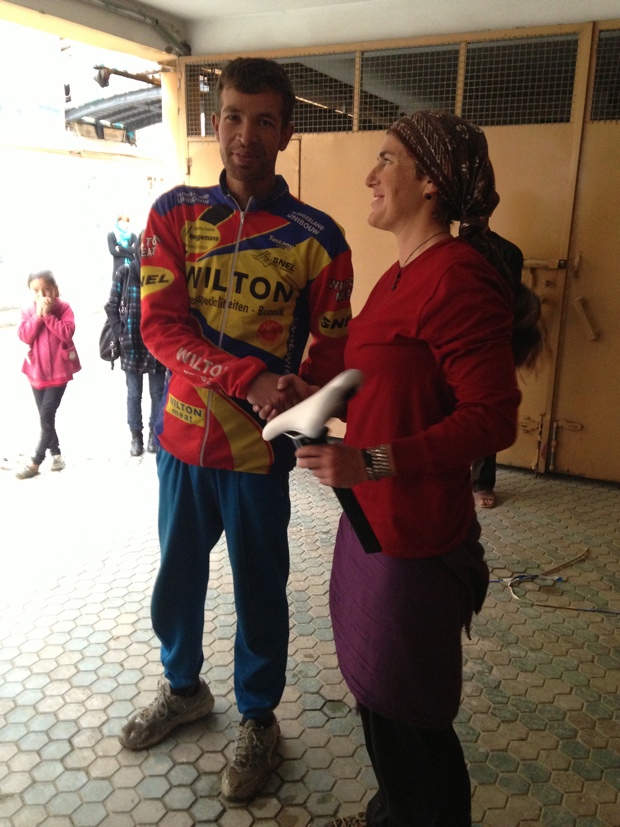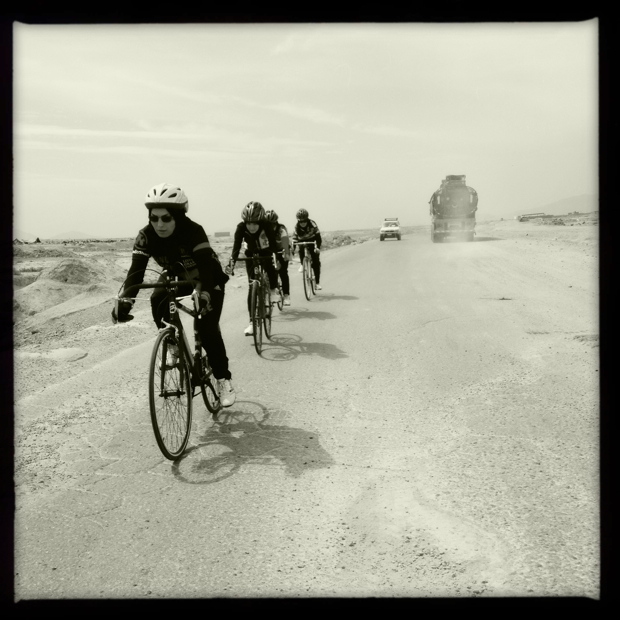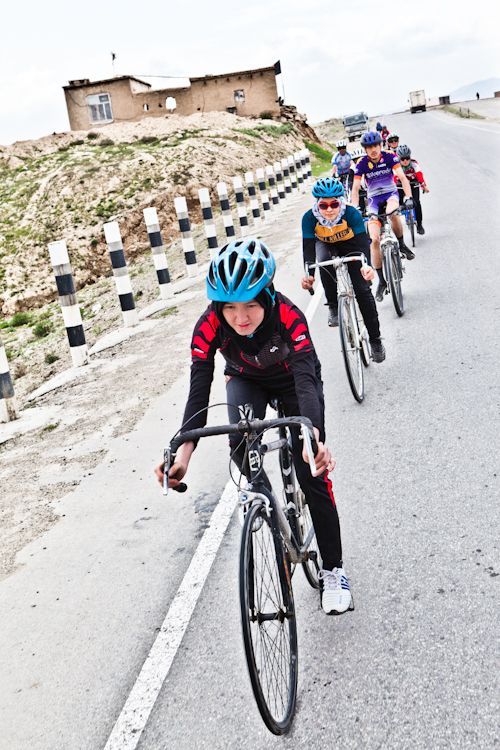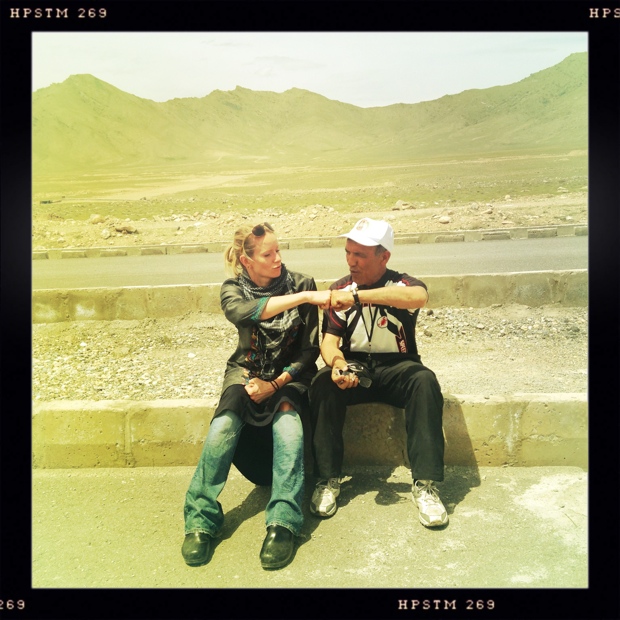After I wrote my first article about the Afghan Women’s National Cycling Team I wrote to Shannon Galpin, the woman working to help them get formed into a professional squad, and requested an interview. There were several articles being written or recorded by bigger media outlets, but so much more I wanted to know about the team and about the women. For the first time in many months I was excited to try to get a story and an interview. Ms. Galpin graciously accepted, but her schedule and her time in Afghanistan did not allow for us to speak on the phone or via Skype. So, we did it via email.
Here is a link list for all articles referenced during this interview: Bicycling Magazine: Watch Out Rio Bicycyling Magazine: Afghan Cycling Federation NYTimes: Shannon Galpin Has a Mission Putting Afghans on Bikes DailyNightly NBC News: Teenage Cycling Prodigy Leads Afghan Women to New Freedoms
Here is our conversation. All emphasis is mine.
Bikezilla (Bz):
From photos and videos I’ve noticed a few things about the team’s equipment and gear: the girls are riding a mix of bikes, not just different brands but different types of bikes (road and MTB, articles mention cruisers); the women and the men both have a mixed bag of uniforms on; one article that I read (I forget which one at the moment) mentions you bringing a “room full of high end bikes”; the women ride without gloves. Some of those things would not be acceptable even to many mere club riders in other countries. What are your thoughts on this? What do the women on the team think about their gear and equipment?
Shannon Galpin (SG):
“None of the girls own their own bikes. The coach has a collection of random bikes, mountain and road, old and older, some with kickstands, all heavy as hell. They are grateful for any support and equipment they can get. We brought over 5 racing bikes donated by Liv/giant, and will have another 7 to bring over this fall so that the girls can start training and racing on lighter, more race specific bikes. We also brought over 350 pounds of clothing and gear for the men’s and women’s teams: clothing, helmets, shoes, socks, gloves, etc. to start getting the teams into proper cycling attire.”
Bz: With it being noted that Afghanistan’s roads are generally not in excellent condition, how do those high-end bikes hold up? How do they get repaired or replaced when carbon fiber parts crack or break? Would high quality steel frame bikes be helpful for training?
SG:
“The high end bikes will mostly be used for racing, as there is not a safe way to transport them around Afghanistan for daily/weekly training. There are no bike racks, and no minibus, so in order to protect them, they are for specific training days and racing until we can solve that problem. They need a fleet of steel road bikes that we could donate to the girls and boys directly, not to the federation, so that they each have a bike to train on and keep at home.”
Bz: It seems that, despite the generosity of bike shops, bike manufacturers and gear manufacturers, that equipment and gear are a very precious commodity. What are the team’s needs, not only immediately, but ongoing?
SG:
“At this point, it’s ground zero. They need indoor trainers, they need bikes, ideally steel racing bikes that can take a beating for training in Afghanistan, they need helmets, spd pedals and cleats, shoes, gloves, chamois, chamois cream, hydration and nutrition supplements. The biggest barrier is transportation due to the security and logistical limitations – so we are trying to raise money to rent or buy a minibus for the team that could carry the girls and their bikes safely around Afghanistan for training. This is by far their biggest need. But most of all they need coaching, training and nutrition development, and funding to help support travel and racing.”
Bz: There’s a quote in the NBC videos, “… winning medals and regional competitions.” In a Bicycling Magazine photo some of those medals can be seen. What and where are these competitions?
SG:
“So far the team has competed in Pakistan and India. Regional races and at the Asia Games in India.”
Bz: Who does the team compete against?
SG:
“They are regional competitors of Pakistan and India – both of which are similar in skill level. The Asia Games has over 40 countries in the region competing.”
Bz: Who are their greatest rivals (names, teams and countries)?
SG:
“Malayasia and Kazakastan are strong Asia competitors. They have strong cycling programs and competitive cyclists which serve as an example to the Afghan women as to what competitive cycling looks like. In the region they (the Afghan team: Bz) are in a similar field of development as Pakistan which is just seeing women on bikes as well.”
Bz: Who is the best GC rider, the best climber and the best sprinter on the team?
SG:
“They are all similar riding levels, the best riders on the team are Nazifa, Sadaf, Maryam, and Farzana… but that’s more about their overall endurance. They are literally the first women to competitively ride bikes, and many of them have only been riding for a year or two. “They are building up their strength, and their endurance, as well as basic bike handling skills. None of them are even riding in clipless pedals yet. This is about witnessing the beginning of a sport.”
Bz: Which two girls are the the most competitive with each other?
SG:
“They aren’t competitive with each other at this point. It’s a lot of camaraderie, and their focus is more about getting more girls and women on bikes and building up more teams, and more riders.”
Bz: What are the toughest climbs in the area (name, location, % grade, distance).
SG:
“I don’t want to talk about locations due to security. I wouldn’t know the name or grade either unless I went out and measured them.”
Bz: Ok, that’s fair and makes sense. Do the women’s teams based in India and Pakistan struggle with the same issues as the women in Afghanistan? How long have those teams been established? Are there more regional women’s teams forming or attempting to form?
SG:
“The girls in Pakistan are in a similar situation as those in Afghanistan from a cultural stand point – although without the additional logistical issues of security and infrastructure. “A woman in Karachi (Pakistan: Bz) has reached out to me interested in starting up a bike team, and it’s definitely inspiring to see women in countries that have long considered cycling taboo or culturally offensive taking up the sport and changing the perception of women and athletes in their countries and throughout the world.”
Bz: A Bicycling Magazine article mentions that the women’s team trains “biweekly” (another BM article states that the men’s team practices 3 days per week). Is that correct, the women only get to train on the road once every two weeks? How do they manage to prepare for their race schedule and perform so well (winning medals) on such a meager training schedule?
SG:
“They train once or twice a week, working around school schedules, and the logistics of having to have the coach pick them and their bikes up and take them to the ride location. They are not able to train solo or with their teammates due to security, so one option is indoor trainers, which is something we are working to get them more of for the next equipment donation. “Indoor cycling is the best option to bump up their training as security, logistics, and timing all works against more outdoor cycling at this point in time.”
Bz: According to a Bicycling Magazine article, Coach Abdul Saddiqi‘s daughter, Benafscha, at age 13 won her first cycling race riding a cruiser. Not a road bike, not even a MTB, but a cruiser, and likely a used Chinese “down brand” cruiser. Do the girls still ever have to ride these bikes? Race on them?
SG:
“Most of the girls ride on these kind of bikes. Literally old steel bikes with kickstands. They race on them too, although that will change now with the Liv/giant donation and support.”
Bz: American and European teams, even at the Continental level, often have bikes for training and bikes for racing, or ready replacement bikes should something go wrong. How does the bike situation of the Afghan National Women’s Team compare to that?
SG:
“They have whatever bike the coach or the cycling federation has for them to ride, and if it breaks down during a race, the mechanic tries to repair it. We have a wheel sponsor with Inertia Racing Technology that is going to send over wheel sets for the men’s and women’s team which will make a huge difference, but it’s still a matter of getting the men’s and women’s team decent training equipment and backup racing equipment.”
Bz: Now that the women have their passports, is there any chance that some of them might be invited to train or even race with teams in other countries and continents (the U.S.? Australia? Europe?)?
SG:
“Yes, this is something we are working on – to help with team development, but more importantly with coaching and training development so that the teams can improve organically and sustainably over the upcoming years.”
Bz: Could you tell me what teams or countries you’re working with or considering for this?
SG:
“We are looking into several options for the team – US, Europe, Iran are all options – the difficulty lays with visas and funding.”
Bz: How many women are on the team?
SG:
“The national team has 8-10 women. There are three regional teams in Afghanistan as well, teams of girls and young women. Forty-eight to fifty are registered, that are riding their bikes as part of the federation in hopes of building more exposure to women about cycling in Afghanistan and to develop more depth of riders for the national team. Due to logistics, right now the national team is made up of Kabul based riders plus one from a neighboring province of Parwan.”
Bz: How many women have tried out to make the team?
SG:
“Most girls that want to ride, are allowed a place on the local team, the numbers are incredibly small.”
Bz: How do these women hear about the team and about openings?
SG:
“Finding out about the team, its totally random and organic, there is no specific ‘call to action’. One girl literally found out from a client at the beauty shop she works at.”
Bz: A Bicycling Magazine article mentions boys of 9 and 12 years old repairing bikes professionally. Who repairs the team’s bikes? How old are the team’s mechanics? What their personal and professional backgrounds?
SG:
“There is a team mechanic, a friend of the coach that repairs the team’s bikes. But in town, you can go to nearly any street and find a ‘bike shop’ where you could fix a bike.”

AWT team mechanic shaking hands with Ky Hunter, the woman sent by Liv/giant to assemble the donated race bikes and help out as a bike mechanic. Photo by Shannon Galpin.
Bz: Are the girls becoming able bike mechanics, too, out of necessity?
SG:
“They are not, but its something I would like to see change out of necessity and to make them more self confident on the bike.”
Thank you, Shannon.
END Part 1
To contact Shannon Galpin or to donate to the Afghan Women’s Team:
Shannon Galpin
Mountain2Mountain
PO Box 7399, Breckenridge, CO 80424


















No Comments